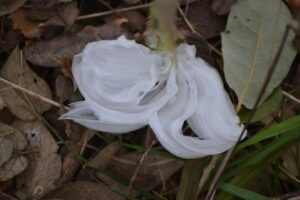
Frozen Stem
by CMG Betty J
Frequently in winter, a Central Texas native plant, Verbesina virginica, exhibits its unusual winter behavior. When the temperature suddenly drops below freezing, the water in the stems of the plants freezes and bursts open, displaying fanciful ice formations, usually in January or February. These formations give the plant its common name, Frostweed. If there has been a sudden drop in temperature, check the edges of wooded areas early in the morning to find a Frostweed display.

Frostweed Curls
How does it happen? The earth must be warm enough so the live roots of the plants are still drawing water up through the stem. When the temperature suddenly plummets below freezing, the exposed stem freezes and the liquid cannot be drawn up through the xylem* past the ice blockage. The stem splits open and forces the water out of the split where it freezes into curls, spirals and ribbons.
In the summer, frostweed is a gangly wildflower with plentiful compound white flower heads. A member of the aster family, it grows best in partial shade, often at the edge of woods so it can catch sunlight and also be shaded.

Frostweed at Woods’ Edge
The Edwards Plateau offers many environments suited to it. Its unbranched stem can be as tall as six feet and has slightly toothed leaves. It is a prime nectar source for Monarch butterflies and bees; beetles and wasps are very fond of it, too. Frostweed blooms from August to November and is well suited to a naturalized landscape. It is drought tolerant and easy to propagate from seeds or roots and forms loose colonies as it spreads through rhizomes. Its native range is from central Pennsylvania to Florida and west to central Texas.
*xylem – plant vascular system that transports water and nutrients from the roots to the stem and leaves